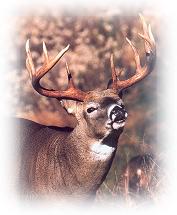RATTLING: The noise you make when rattling antlers together imitates the sound of an ensuing antler battle. Bucks respond to rattling much more frequently than does do. It is thought that rattling attracts bucks because they may be attempting to assert their dominance, or possibly steal the doe the bucks are fighting for.
Rattling is most effective during the rut, and for a few weeks before and after the rut. Rattling is more effective in areas where bucks outnumber does. Rattling works best in open areas on calm days, and is not very effective in high winds or in heavy timber because the sound doesn't get carried very far.
Before you attempt to rattle, you need to make sure your stand is downwind of heavy cover where the bucks may be. You need to have at least a 180 degree shooting zone to work with. Begin rattling for no more than one or two minutes so that you don't scare off any deer that may be nearby. Wait approximately five minutes to check for deer and begin rattling again if none are in sight. If none appear, it is probably safe to begin rattling more vigourously for several minutes.
You may want to try raking brush or pawing at the ground with the antlers to simulate the sounds of an actual buck fight. If nothing happens, you may want to try rattling again or move to another location. You should move at least one half of a mile in an open field, or no more than one quarter of a mile in heavily wooded areas or in strong winds. Always be prepared to shoot.
When a buck hears the rattling noises, he will usually try to circle downwind towards your position, but he could possibly approach very quickly. If a buck is within sight, you may want to try luring him in closer with a grunt call. Life sized deer decoys are sometimes beneficial at this point.
CALLING: Most hunters are partial to grunt tubes because they imitate the soft, low pitched grunts of a buck tending to a doe. These grunt sounds will attract other bucks and occasionally does. Calls that make the bleat of a doe or the mew of a fawn can attract bucks, but more likely will attract does or fawns. Calling can attract deer whether you're in a tree stand or still-hunting.
Make sure you only call deer you can see or hear. You are wasting your time otherwise since the sounds from these calls will only travel 200 yards or less under the best conditions. You should only call deer that are standing still. When calling bucks, always begin with a short, soft grunt. Usually, he will respond almost immediately. If not, try again. If there still isn't a response, try about three short, soft grunts and one longer slightly louder grunt. If he still doesn't respond, you should stop calling.
Once the deer starts walking in your direction, stop calling immediately. If you don't, he will be able to spot you and identify you as a threat. One of the most common mistakes of inexperienced hunters is to call too loud and too often. |

